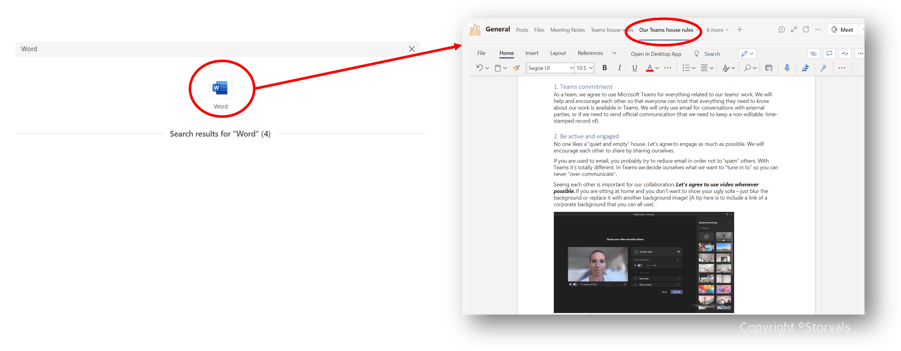In our blog post 'How to succeed with Microsoft Teams' we mentioned that you should lead by example and that it is good to agree on some common 'House Rules'. We have since elaborated a bit more on these house rules and included a section on what the reactions or so-called expressions (or simply emojis) in Microsoft Teams mean. You don’t want these symbols to lead to any misunderstandings in your team. Please feel free to download and copy these rules and edit them as you wish for your team. It looks best if you implement them as a SharePoint page, but you can also insert a tab with a Word document (if you want it to be easily editable) or a PDF document.

1. Teams commitment
As a team, we agree to use Microsoft Teams for everything related to our teams’ work. We will help and encourage each other so that everyone can trust that everything they need to know about our work is available in Teams. We will only use email for conversations with external parties, or if we need to send official communication (that we need to keep a non-editable, time-stamped record of).
2. Be active and engaged
No one likes a “quiet and empty” house. Let's agree to engage as much as possible! We will encourage each other to share by sharing ourselves.
If you are used to email, you probably try to reduce email in order not to “spam” others. With Microsoft Teams it’s totally different. In Teams, we decide for ourselves what we want to “tune in to” so you can never “over-communicate”.
Seeing each other is important for our collaboration. Let's agree to use video whenever possible. If you are sitting at home and you don’t want to show your ugly sofa – just blur the background or replace it with another background image! [A tip here is to include a link of a corporate background that you can all use]. If you don't feel comfortable being on camera, use your avatar!
.png?width=900&height=539&name=Teams%20Avatars%20-%20Sanda%20and%20Ulrika%20Copyright%20(Small).png)
3. Contribute to an open dialog
Let’s agree to use channel posts for everything that could be of interest to others in the team – not private chats. The whole idea of Teams is that we want to create an open dialog. If you use group chats for your communication instead of channel posts – you create silos within our team. In our “house” we want everyone to be able to listen in and join other people’s conversations – we don’t want people whispering behind closed doors.
Group chats are great for things that add no value to the ones outside that chat. For instance, “Stuck in the metro”, “Running late” – “Lunch anyone?”
Let’s agree to only use private channels if the information is sensitive and confidential and should not be seen by others in the team.
4. Be kind and supportive
This is a no-brainer but still good to have as one of our house rules. In Teams, you have so many ways to show your support – using reactions, GIFs, stickers, Memes, and much more. Let’s be respectful to each other and show our support for one another.

5. Let’s agree on what we mean
Using reactions or so-called expressions (or emojis) in Teams is great. With a click of a button, you can just show what you mean. But what do we mean?
Let’s agree on what the expressions mean so that using them doesn’t lead to any misunderstandings: We agree that:
![]() Like = I like it! I agree! Thumbs up! I’ve seen it. Good job! Acknowledged. Got it! Thanks!
Like = I like it! I agree! Thumbs up! I’ve seen it. Good job! Acknowledged. Got it! Thanks!
It does not mean = Approved. Go ahead. Confirmed. Do it. Buy it.
![]() Heart = Love it! Wonderful! So sweet. That is so kind of you. THANK YOU!
Heart = Love it! Wonderful! So sweet. That is so kind of you. THANK YOU!
It does not mean = Anything inappropriate.
![]() Laugh = That’s funny. That makes me so happy.
Laugh = That’s funny. That makes me so happy.
![]() Surprised = What??!?!!! Really?! I’m surprised. Oh my!
Surprised = What??!?!!! Really?! I’m surprised. Oh my!
![]() Sad = That’s so sad. I’m sorry to hear that. I empathize with you.
Sad = That’s so sad. I’m sorry to hear that. I empathize with you.
![]() Angry = That makes me so angry. That is upsetting. That is so wrong.
Angry = That makes me so angry. That is upsetting. That is so wrong.
